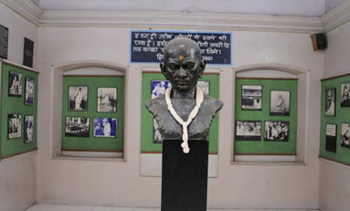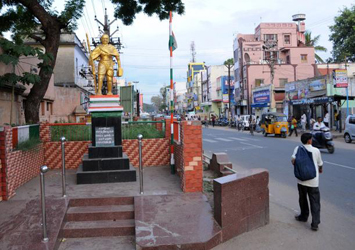Gandhi's deliberations climaxed in Madurai

Gandhi donned loin-cloth for the first time at Madura to identify himself with India's poor.
“All the alterations I have made in my course of life have been effected by momentous occasions; and they have been made after such a deep deliberation that I have hardly had to regret them. And I did them, as I could not help doing them. Such a radical alteration - in my dress, - I effected in Madura.”
- M. K. Gandhi
Ninety-three years back, on September 22, 1921, Mohandas Karamchand Gandhi took the brave decision to shed his traditional attire and get into a ‘loincloth,’ which remained with him till death. The historic decision of the Mahatma to identify himself with the common man embellished Madurai’s reputation as an ancient city that enhanced even an ordinary man’s spiritual strength. He later recalled that though he came closer to taking a decision on his clothing on a couple of earlier occasions, it was Madurai that gave him the necessary strength.
The Barisal root
 When people were burning foreign clothes to mark their boycott, Mahatma Gandhi first thought of changing his attire in Barisal in Bengal where he was “twitted that I was burning cloth utterly regardless of the fact that they [famine-stricken people of Khulna] were dying of hunger and nakedness.” At this moment, he felt that he should content himself with a mere loincloth and send his shirt and dhoti for the people of Khulna. But he realised that he needed nothing to do there as people in Khulna were being helped and “only a single zemindar could have sent all the relief necessary.”
When people were burning foreign clothes to mark their boycott, Mahatma Gandhi first thought of changing his attire in Barisal in Bengal where he was “twitted that I was burning cloth utterly regardless of the fact that they [famine-stricken people of Khulna] were dying of hunger and nakedness.” At this moment, he felt that he should content himself with a mere loincloth and send his shirt and dhoti for the people of Khulna. But he realised that he needed nothing to do there as people in Khulna were being helped and “only a single zemindar could have sent all the relief necessary.”The second occasion was the arrest of his friend Maulana Mahomed Ali. At the meeting held immediately after the arrest, the Mahatma thought of dispensing with his cap and shirt but restrained himself “fearing that I might create a scene.”
Madras Moments
 The thought visited him again in September 1921, during the Madras tour, when people told him that they did not have enough khadi and if it was available they had no money. The query, “If the labourers burn their foreign clothing, where are they to get khadi from?” stuck into his heart. “I felt there was truth in the argument. The plea for the poor overpowered me,” he wrote in Navajivan on October 2, 1921.
The thought visited him again in September 1921, during the Madras tour, when people told him that they did not have enough khadi and if it was available they had no money. The query, “If the labourers burn their foreign clothing, where are they to get khadi from?” stuck into his heart. “I felt there was truth in the argument. The plea for the poor overpowered me,” he wrote in Navajivan on October 2, 1921.It took a few more days and a few hundred kilometers of travel for the thought to translate into action. It did happen on September 22, 1921, at 251 A West Masi Street, during the second of his five visits to Madurai, on the upstairs room of the house of one of his followers. On that day, he was to travel towards Ramanathapuram and had asked to be picked up in the morning. When Congress functionaries arrived at the house, which now houses a khadi showroom, they found Gandhi in a new attire. Though he was to travel beyond Madurai to address the public, the Mahatma was forced to stop on Kamarajar Salai to accept the greetings of people. The place where he made his first public appearance in a loincloth is referred to as ‘Gandhi Pottal’ now.
The implications of the makeover made in Madurai were many. The Mahatma wrote in Navajivan, the translation of which was reproduced in The Hindu on October 15, 1921: “I do not want either my co-workers or readers to adopt the loincloth. But I do wish that they should thoroughly realise the meaning of the boycott of foreign cloth and put forth their best effort to get it boycotted, and to get khadi manufactured. I do wish that they may understand that swadeshi means everything.”
“The adoption of a dhoti and a shawl in the place of elaborate Gujarati attire is a symbolic external manifestation of an internal revolution. The dress of liberty turned into the Mahatma’s identity,” said M. P. Gurusamy, secretary, Gandhi Museum.
T. Ravichandran of the Department of Gandhian Thought and Peace Science, Gandhigram Rural Institute, recalls that when he introduced himself as a person from Madurai in a meeting with Pope John Paul II in Vatican in November 1994, the Pope immediately recalled the adoption of loincloth by Gandhi and called it a “spiritual act.”